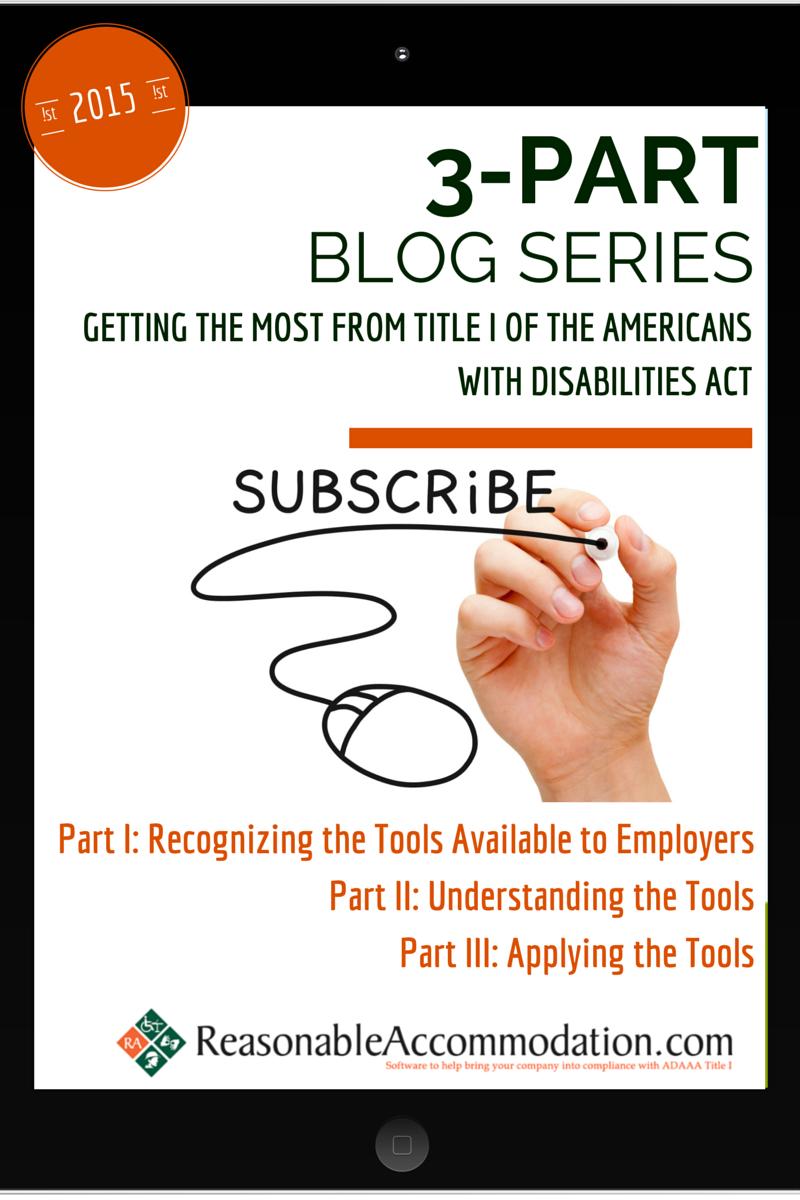This is the 2nd blog in the 3-part series. This three part blog series will acquaint you with the hiring, disability, and absence management tools Congress provided to employers through Title I of the amended Americans with Disabilities Act.
************************************************************************************
Module Two – ADA Title I: Understanding the Tools Available to Employers
The Congress of the United States, the Equal Employment Opportunity Commission and  the Federal Courts have each shaped how the tools available to employers under Title I of the amended ADA can legally be used. In the previous blog in this series we named each of the tools by linking them to the actual code of the law. I will follow this same process as we seek to understand how each tool can be used.
the Federal Courts have each shaped how the tools available to employers under Title I of the amended ADA can legally be used. In the previous blog in this series we named each of the tools by linking them to the actual code of the law. I will follow this same process as we seek to understand how each tool can be used.
SUBCHAPTER I [TITLE I] – EMPLOYMENT
DEFINITIONS
SEC. 12111.
(8) Qualified individual. – The term “qualified individual” means an individual who, with or without reasonable accommodation, can perform the essential functions of the employment position that such individual holds or desires. For the purposes of this subchapter, consideration shall be given to the employer’s judgment as to what functions of a job are essential, and if an employer has prepared a written description before advertising or interviewing applicants for the job, this description shall be considered evidence of the essential functions of the job.
One foundational tool in Title I is actually the definition of the job. This may not sound like a “tool” but you will find that discussions about whether or not someone is eligible to be considered for a receive reasonable accommodation or should be retained in a position often gets down to whether or not they are qualified to hold the job. An example of being qualified can be seen in the job of delivery driver. It should be obvious that one needs a commercial driver’s license to hold that job. But if an individual loses the license due to a DUI, for example, they are no longer qualified for the job. A request for reasonable accommodation does not have to be considered because the person cannot legally hold the job. If the individual wants to return to the job then a new license must be acquired. Leave or other reasons for being away from work may take a back seat to the lack of a license.
So, to ease the burden of managing hiring, SAW, or RTW cases define the qualifications of the job!
(9) Reasonable accommodation. – The term “reasonable accommodation” may include-
(A) making existing facilities used by employees readily accessible to and usable by individuals with disabilities; and
(B) job restructuring, part-time or modified work schedules, reassignment to a vacant position, acquisition or modification of equipment or devices, appropriate adjustment or modifications of examinations, training materials or policies, the provision of qualified readers or interpreters, and other similar accommodations for individuals with disabilities.
As I said in the first installment of this series, reasonable accommodation is one of the most important tools provided to employers by the amended ADA. A well-organized reasonable accommodation (RA) process goes a long way toward keeping qualified people at work and bringing back people who are returning to work.
Here is a powerful concept: if you have people who are absent for some reason, your RA program very well could make the difference between having them remain unproductive while locked into a workers compensation system that is not focused on returning them to work. Or, a strong and fair RA program could be the tool for moving them away from a no-win WC system toward RTW or case settlement. The tools of “qualified individual” and “safe reasonable accommodation”, when understood, can be a strong lever for moving people along. In essence you are saying to the qualified individual, “it’s time to get back to work. You can resume work because we are able to change how the job is accomplished.” If the person is medically able to return to work and they can be accommodated, what is the reason they would remain absent? And if they do not accept the offered accommodation they must justify why it would be unsafe or ineffective.
If the above is something you have not considered, get in touch with me and/or follow this blog space for more of my thinking on the power of these tools.
(d) Medical examinations and inquiries. –
(1) In general. – The prohibition against discrimination as referred to in subsection (a) of this section shall include medical examinations and inquiries.
(4) Examination and inquiry. –
(A) Prohibited examinations and inquiries. – A covered entity shall not require a medical examination and shall not make inquiries of an employee as to whether such employee is an individual with a disability or as to the nature or severity of the disability, unless such examination or inquiry is shown to be job related and consistent with business necessity.
(B) Acceptable examinations and inquiries. – A covered entity may conduct voluntary medical examinations, including voluntary medical histories, which are part of an employee health program available to employees at that work site. A covered entity may make inquiries into the ability of an employee to perform job-related functions.
(C) Requirement. – Information obtained under subparagraph (B) regarding the medical condition or history of any employee are subject to the requirements of subparagraphs (B) and (C) of paragraph (3).
Once again, as mentioned in my first installment of this blog series, “medical examinations and inquiries” is another set of tools to get an absence case moving again. As an employer you have the right to test individuals within a narrow set of circumstances. Among them is a concern for safety of the on-the-job individual or for the returning-to-work absent employee. The key to the testing tools is to know the physical demands of the essential functions of the job. The testing process compares the known demands of the job to the safe abilities of the person in question. If the person does not have the ability to safely perform the demands of the job we know two things: (1) the person’s safe current ability, and (2) the demand of the current job that must be accommodated to keep them in that position. With this information we can return them to work in the same job without accommodation, accommodate them in the existing position, or transfer them to a job whose demands are within the current abilities.
Under the umbrella of testing the absent employee is the practice of confirming a physician’s restrictions to ensure that the job has higher demands than the restriction in order for the person to remain off of work. That is to say, let’s double-check the physician’s estimate: does the individual indeed have less ability than the job demands? For example, if a job requires 10 pounds of lifting 4 times per hour and the individual can safely lift 20 pounds 4 times per hour, then the person should be on the return to work path. And if the person is not able to lift 10 pounds, a look at getting back to work through an accommodation should be considered.
The three tools explored above are the foundation for unsticking “stuck” cases. The final installment of this series will explore how to apply these tools.



